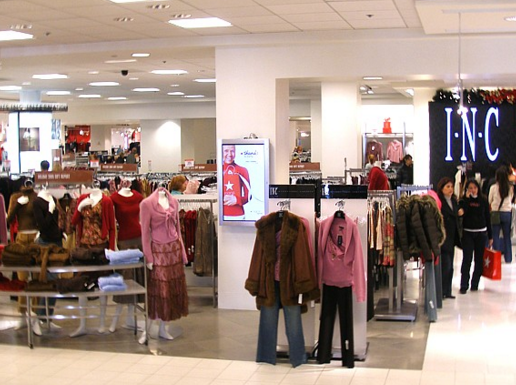
Due to various factors such as warmer than usual temperatures and the rise of more apparel and pure play e-Commerce retailers, many department stores have had declining sales, highlighted most recently by poor holiday results.
Thus far, Macy’s appears to be taking the biggest hits, and as such has made the decision to cut $400 million in costs and lay off nearly 5,000 employees in 2016.
The RTP team debates the chances of the department store model bouncing back in 2016, and highlights which department stores have done the best job weathering the storm.
Debbie Hauss, Editor-In-Chief:
Macy’s has been struggling to get customer service right for some time now, the updated New York City flagship aside. I think the iconic brand will survive and thrive as Terry Lundgren and his team focus on expanding some of the new technology innovations across stores and continuing to add new models such as the Bluemercury store-within-a-store. Similar to other industry segments, department stores need to deliver unique experiences to delight their target shoppers. Nordstrom is obviously ahead of the game because a keen focus on customer service has been a foundational element of everything the brand does. Nordstrom has implemented mobile payment and has offered pop-up shops for some time. Via its internal Innovation Lab team, Neiman-Marcus has been working to introduce innovative technologies, such as the interactive retail tables. But it’s also important to know who your target shoppers are. JCPenney learned that lesson the hard way and is desperately trying to bounce back.
Adam Blair, Executive Editor:
Department stores face structural challenges that were sharply highlighted by two trends this holiday season: a high dollar that discouraged spending by international visitors, and unseasonably warm weather that depressed winter apparel sales. By their nature, relatively slow-moving, brick-and-mortar-heavy department store chains would have found it tough to pivot their merchandising on a dime from ski sweaters to beach volleyball outfits. Those retailers that succeed in today’s fast-changing marketplace will “departmentalize” and diversify: separating into specialty luxury and off-price brands, as Saks Fifth Avenue has done; buying flash sale sites, as Hudson’s Bay did with Gilt Groupe; and stressing customer convenience, as Kohl’s has with expanded buy online/pick up in-store offerings.
Alicia Fiorletta, Content Strategist: Department store retailers that will be able to adapt to changing market conditions are the ones that are nimble and have the systems in place to track trends and quickly respond. Data/analytics can position these department store retailers to better keep pace with shifting customer preferences and buying behaviors. Although it’s impossible for a department store to change out its store assortment due to unseasonably warm weather, the retailer can instead focus on holding special sales and flash sales for these items. It may be just enough temptation for shoppers to make a purchase. And as Adam noted in his response, I also think we’ll see more behemoth brands acquire smaller, more disruptive brands…not only to expand their business portfolio but also to add more innovative minds to their executive suite.
David DeZuzio, Managing Editor:
I’d like to think if anyone can bounce back from a bad holiday season, it would be Macy’s. You don’t stay in business for 157 years without adapting to new trends, disruptors and updating business models. While layoffs are unfortunate, it is vital to reorganization and moving forward. However, smaller department stores, if they are not already in the process of restructuring their business models and expectations, are in a much tougher position to bounce back. Rents never go down and if customers aren’t coming through the doors, in good or bad weather, those doors will close. Ultimately, if you aren’t offering something incredibly engaging in a physical location, you can’t beat clicking on a button for cheaper prices and free shipping.
Kohl’s and Nordstrom would be my top picks as to who is weathering the storm and their successes may be inherent; Nordstrom has the benefit of being a high-end department store with fewer physical locations while Kohl’s appeals to a broader audience and has better price points.
Klaudia Tirico, Associate Editor:
We can blame seasonal factors for poor department store sales during the past holiday season, but, overall, the biggest concern should be the rise of e-Commerce. How are department stores going to compete with the ever-changing times and habits of Millennials? They have got to chuck the old rules out the window. Department stores need to change the experience, which includes changing their assortment of products and how they present them to get customers to want to come back. No one wants to sift through racks of bland product any more when they can go to well-curated sites like Net-A-Porter. Nordstrom has done a great job with getting customers to come back to stores with the inception of the Nordstrom Pop-In, a pop-up shop experience inside Nordstrom stores with a rotating selection of items. It’s this kind of forward thinking that can get department stores back on track.
Glenn Taylor, Associate Editor: While the weather had its effect on the past few months of spending, there are simply many more options for the consumer to spend their money than there were 20 years ago. Frankly, consumers don’t have to shop at these stores to grab the items they are looking for. On these grounds, I don’t foresee department stores ever replicating their past success. However, that’s not to say they can’t be successful, it just means they have to adapt to the qualities many contemporary retailers are offering. Although JCPenney was the poster child for the decline of the department store prior to 2015 and is planning on closing more stores in 2016, the retailer has done an excellent job stabilizing its business. It has since added new offerings such as rebranded InStyle Salons and personalized notes upon in-store pickup. Neiman Marcus is an example of a retailer building an innovation lab dedicated to creating technology that makes for a more compelling store experience.






